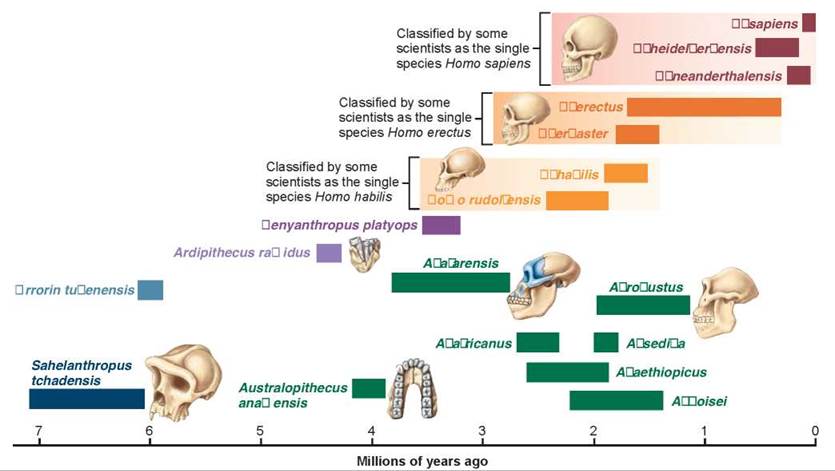THE LIVING WORLD
Unit Five. Evolution of Animal Life
21. How Humans Evolved
The Oldest Known Hominid
In recent years, anthropologists have found a remarkable series of early hominid fossils extending as far back as 6 to 7 million years. Often displaying a mixture of primitive and modern traits, these fossils have thrown the study of early hominids into turmoil. While the inclusion of these fossils among the hominids seems warranted, only a few specimens of these early genera have been discovered, and they do not provide enough information to determine with a degree of certainty their relationships to australopithecines and humans. The search for more early hominid fossils continues.
The First Australopithecine
In 1995, hominid fossils 4.2 million years old were found in the Rift Valley in Kenya. The fossils are fragmentary, but they include complete upper and lower jaws, a piece of the skull, arm bones, and a partial tibia (leg bone). The fossils were assigned to the species Australopithecus anamensis; anam is the Turkana word for “lake.” While clearly australopithecine, the fossils are intermediate in many ways between apes and a 3-million-year-old, more complete, fossil called Australopithecus afarensis. Numerous fragmentary specimens of Australopithecus anamensis have since been found.
Most researchers agree that these slightly built A. anamensis individuals represent the true base of our family tree, the first members of the genus Australopithecus, and thus ancestor to A. afarensis and several other species of australo- pithecines (figure 21.5) whose fossils have been discovered.

Figure 21.5. A hominid evolutionary tree.
In this tree, the most widely accepted, the horizontal bars show the dates of first and last appearances of proposed species. Seven species of Australopithecus and seven of Homo are included, as well as four other newly described early hominid genera.
Differing Views of the Hominid Family Tree
Investigators take two different philosophical approaches to characterizing the diverse group of African hominid fossils. One group focuses on common elements in different fossils, and tends to lump together fossils that share key characters. Differences between the fossils are attributed to diversity within the group. Other investigators focus more pointedly on the differences between hominid fossils. They are more inclined to assign fossils that exhibit differences to different species. For example, in the hominid evolutionary tree presented in figure 21.5, “lumpers” recognize three species of Homo (they group the red bars into one species, the dark orange bars into a second species, and the light orange bars into a third species). “Splitters,” on the other hand, recognize no fewer than seven species (each of these bars indicating a separate species)! Until we have more fossils, it is not possible to decide which view is correct.
Key Learning Outcome 21.4. The earliest australopithecine yet described is A. anamensis, over 4 million years old. Some researchers assign all fossils of the genus Homo to three species, while others recognize at least seven species.